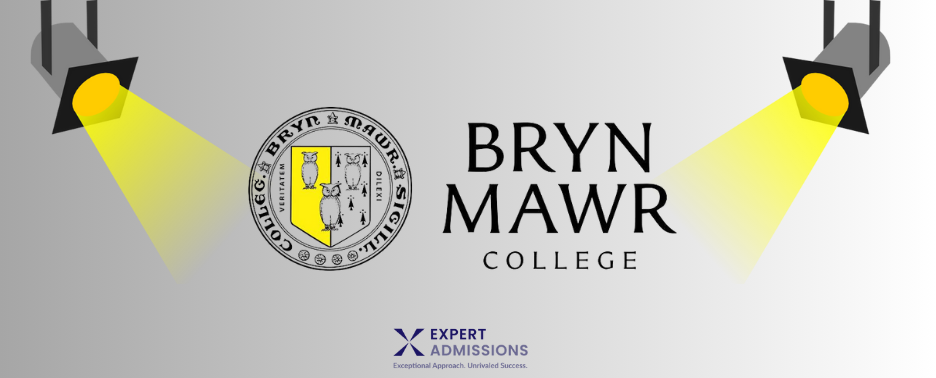
About Bryn Mawr College
Location: Bryn Mawr, PA
Undergraduate Population: 1,742
Most Popular Majors: Psychology, Mathematics, Literatures in English, Biology, Sociology
Demographics:
White 41.1%
Asian/Asian American 9%
Latinx 8.2%
Black/African American 4%
Multiracial 4%
Native American less than 1%
History:
Bryn Mawr was founded as a private women’s liberal arts college in 1885 with the financial backing of physician Joseph W. Taylor. It was one of the first institutions of higher education in the United States to offer both undergraduate and graduate degrees, including doctorates, to women. The first graduating class included 36 undergraduates and eight graduate students. Bryn Mawr was originally affiliated with the Quakers due to Taylor’s own background, but became non-denominational in 1893. In 1891, Bryn Mawr became the first college in the country to approve a student self-government association. This Honor Code allows for unproctored exams, the absence of RAs in dorms, 24-hour lab access, and the lack of an admission enrollment deposit.
In 1931, Bryn Mawr began accepting men as graduate students, while maintaining its focus on women at the undergraduate level. From 1921 to 1938, the Bryn Mawr campus was home to the Bryn Mawr Summer School for Women Workers in Industry, which was founded as part of the labor education movement and the women’s labor movement.
On February 9, 2015, the Board of Trustees announced approval of a recommendation to expand the undergraduate applicant pool allowing transgender women and intersex individuals identifying as women to apply for admission. Today, students at Bryn Mawr can choose from 37 majors that include unique offerings such as “Classical and Near Eastern Archaeology,” “Growth and Structure of Cities,” and “Peace, Conflict, and Social Justice Studies.” They can also register for classes at Hartford, Swarthmore, and the University of Pennsylvania.
Notable Bryn Mawr alumni include actress Katharine Hepburn, author and television personality Liza Oz, historian Drew Faust, playwright Sarah Jones, and Pulitzer Prize-winning journalist Carol D. Leonnig.
Traditions:
- Parade Night is a celebration of the completion of the first week of classes at Bryn Mawr. The incoming first-year students take the juniors as their sibling class. The sophomores are seen as adversarial, and the seniors are apathetic.
- May Day is celebrated on the Sunday after the last week of spring classes. The entire College community comes together for a day of medieval-themed festivities.
- Students make offerings to the campus statue Athena for her gifts of wisdom and strength when taking finals, writing papers, just asking for personal help, and innumerable other reasons.
Noteworthy Features:
- Bryn Mawr has distribution requirements that encourage breadth of learning. Other than requiring courses in fields such as languages, social sciences, and natural sciences, Bryn Mawr also expects students to take a one-unit course that focuses on issues of power, inequity, and justice.
- First-years also take an Emily Balch seminar, which are courses taught by scholars across academic disciplines. Some example seminars include “The Lives of Mathematicians: The Creative Individuals Behind The Mathematics,” “Fantastic Fiction and the Environment,” and “The Modern City of Paris.
- The Bryn Mawr 360o Course Cluster program is an interdisciplinary experience that brings students from a variety of majors together to examine a central theme, like Europe from the Margins or Struggles for Global Health Equity, from multiple perspectives.
Admissions Profile
Average GPA: Not reported
Test Scores (mid-50% range): 1300-1470 SAT/ 29-35 ACT
Admit Rate: 30.7%
Test-optional? Yes
Offers Early Admissions? Yes–Early Decision I and II
Supplemental Essays
Bryn Mawr College’s required essay prompts:
Bryn Mawr students bring their authentic selves to campus. What do you know about yourself to be true – and what in your background or experience led you to that truth? (250-500 words)
Even though it’s worded differently than typical identity prompts, this question encourages students to share more about their background. You can write about any aspect of your identity that is a defining part of who you are, whether that’s your race, gender, religion, sexuality, geographic location, or socioeconomic background.
Consider what you want the school to know about you. Supplemental essays provide further context to your application. So, no matter what you write about your truest self, your response should help admissions officers understand where you come from, what experiences have been meaningful to you, and how you’ll contribute to the diversity of the campus community. Don’t just mention what your background is—talk about how it has shaped you and your perspective.
Why are you interested in Bryn Mawr? (limit: 250 words)
This is a classic example of a “why this college” essay. Ask yourself what stands out the most to you about Bryn Mawr. You could be looking forward to a niche academic program or want to access a particular student organization or campus resource.
During the research process, go beyond information that is easily available on Bryn Mawr’s website. You must show that you’ve dug deeper than just the homepage of your chosen academic department. Read course descriptions, faculty profiles, and seek out information about special programs students participate in. Campus visits really come in handy here—if you can write about your real-life impressions of a school or a department, that’s great! It’s also a great idea to watch admissions TikToks, student Instagram takeovers, and “day in the life” YouTube videos to get a sense of what daily student life is like at the school.
Regardless of what you’re excited about, find ways to connect your interests to unique features of Bryn Mawr. Admissions readers want to know that you’re a good fit—and that your love for the school is genuine.
For more tips on common supplemental essay prompts, see our blog post here.
Leave a Reply